Hilde Holger
Hilde Boman-Behram (née Hilde Sofer, stage name Hilde Holger; 18 October 1905 – 24 September 2001) was an expressionist dancer, choreographer and dance teacher whose pioneering work in integrated dance transformed modern dance.[1][2]
Hilde Holger | |
|---|---|
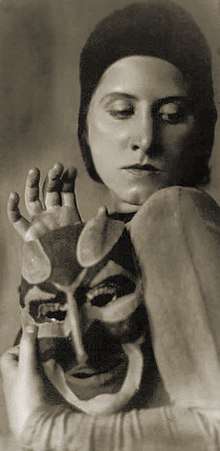 Holger in 1925 | |
| Born | Hilde Sofer 18 October 1905 |
| Died | 22 September 2001 (aged 95) Camden, London |
| Nationality | British, Austrian |
| Known for | Dance, choreography and teaching |
| Movement | Expressionism and Integrated dance |
| Spouse(s) | Adershir Kavershir Boman-Behram (1940–1975, 1989–2000) |
| Website | Official website |
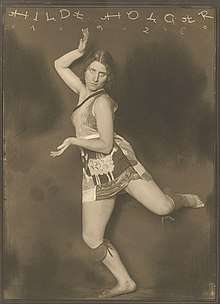
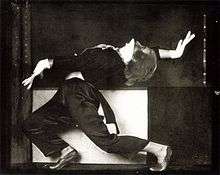
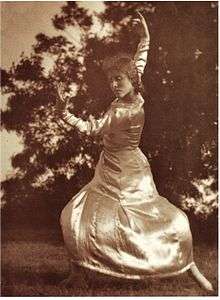
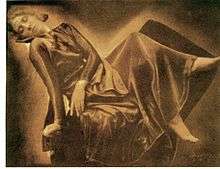
Family
Holger came from a liberal Jewish family. She was born in 1905, the daughter of Alfred and Elise Sofer Schreiber.[3] Her father wrote poetry, and had died by 1908. Her grandfather made shoes for the Austrian court.
After Nazi Germany invaded Austria, Holger fled Vienna in 1939, because her entry into England was denied, she went to India.[4] In Mumbai she met the Parsi homeopath and art loving Dr. Ardershir Kavasji Boman-Behram, they married in 1940.[5] Her mother, step-father and fourteen other relatives all perished in the Holocaust.
Hilde Holger had two children. The first was born 1946 in India, her daughter Primavera Boman-Behram. In New York she became a dancer, sculptor and jewelry designer. In 1948 Holger's family emigrated to Britain.[5] Her second child, a son named Darius Boman-Behram, was born in 1949. He had Down syndrome, but inspired Holger to work with physically disabled people.
Work
Hilde Holger started to dance at age six. At that time she was too young to join the Vienna State Academy of Music and Dramatic Art, so she settled for ballroom dancing lessons taken with her sister (Hedi Sofer), until she was accepted to study with radical dancer Gertrud Bodenwieser,[6] then a professor at the Vienna State Academy. They were admirers of the work of Isadora Duncan and Ruth St. Denis, as well as the artists of the Secession. Holger soon rose to be Bodenwieser's principal dancer and friend, and toured with Bodenwieser's company all over Western and Eastern Europe. She toured with her own Hilde Holger Dance Group as well. At age eighteen she had her first solo performance in the Viennese Secession. Later in the Viennese Hagenbund and theaters in Vienna, Paris and Berlin, her much-lauded expressionist dance caused quite a stir. Because of her passion for dance, in 1926 she formed the New School for Movement Arts in Palais Ratibor, right in the heart of Vienna. Her children's performances were danced in parks and in front of monuments there.
On 12 March 1938 Adolf Hitler's Nazi Germany sent troops into Austria, and adopted a law to unify the country with Austria, at that time it was forbidden for Jews to perform. She received help to flee Austria from her friend Charles Petrach. She decided to go to India because that country's art was the most compelling to Western people, she said at that time.
In India she had the opportunity to incorporate new experiences into her work, especially the hand movements of Indian dance. Classical Indian dance has over three hundred of them, used to express life and nature. In 1941 Holger founded a new school of dance in Bombay, she took students of all race, religion and nationality without prejudice. Like when she was in Vienna, Holger again took part in the artistic community. Amongst her friends with whom she collaborated with were the Indian dancers Rukmini Devi Arundale, Ram Gopal,[2] Madame Menaka and Uday Shankar.[7] Gopal also danced in Holger's school in Bombay. In 1948 because of the partition of India and the growing violence between Muslims and Hindus she emigrated again, this time to Britain.
Once in England, her Holger Modern Ballet Group performed in parks, churches and theaters. She again opened a new dance school, The Hilde Holger School of Contemporary Dance and remained faithful to their style of teaching that the body and mind must form one unit in order to be a good dancer. Her breakthrough in London, 1951, celebrated Holger with the premiere of "Under the Sea", inspired by the composition by Camille Saint-Saens.
In 1972 she performed a piece titled "Man against flood", it was based on the book of the same name written by Chinese Communist Party member Rewi Alley. It was performed at the Commonwealth Institute with music by Chinese composer Yin Chengzong, and included dancers forming a human wall against a flood of water.[8]
Her performance "Apsaras" (1983) explored her experiences in India. In the summer of 1983 she went back to India, where she had been last in the year 1948. There she worked as a choreographer for a large dance group directed by Sachin Shankar.
Holger was particularly proud of her work with the mentally handicapped. She created a form of dance therapy for children who, like her son Darius, have Down syndrome. Holger was the first choreographer who mixed professional dancers with young adults with severe learning disabilities. In 1968 at the Sadler's Wells, Holger orchestrated "Towards the Light", with music by Edvard Grieg. It was pioneering, innovative, and one of the first integrated dance pieces to be seen on a professional stage.[9]
In 1992, Holger revived four dances from her early repertoire for her student Liz Aggiss, who first performed them, as Vier Tanze, at the Manchester Festival of Expressionism.[10]. The pieces were Die Forelle (1923), Le Martyre de San Sebastien (1923), Mechaniches Ballett (1926) and Golem (1937). In the Guardian review, Sophie Constanti wrote that 'Hilde Holger's choreography reaches the British stage at last and triumphs....Together all four pieces danced with great sensitivity and aplomb by Aggiss accompanied by (Billy) Cowie on piano provided a fascinating insight into the lost Ausdruckstanz of central Europe.'[11]
Legacy
Hilde Holger left a lasting impression on three generations of dancers and choreographers. While teaching her standards were high and she was not afraid of risk.[2] She accepted students without prejudice, including students with disabilities, as long as they were sincere. One of her students, Wolfgang Stange, continued her work with people with learning difficulties, like Down syndrome and autism, as well as people with physical disabilities. Stange's Amici Dance Theatre Company which was the first physically integrated dance company in Great Britain, which created a performance titled "Hilde" that was performed at the Riverside Theatre in London in 1996, and at the Odeon in Vienna in 1998. This HILDE Performance in Vienna excited the Ballet Master of the Vienna State Opera Ballet, who in turn put a performance on the stage of the Opera House with people with learning disabilities. These performances were received with great applause!
In her last few weeks Holger still held dance lessons in her basement studio in Camden, London, where she lived for more than fifty years. Her students included Liz Aggiss, Jane Asher, Primavera Boman, Carol Brown, Carl Campbell, Sophie Constanti, Jeff Henry, Ivan Illich, Luke Jennings, Thomas Kampe, Claudia Kappenberg, Cecilia Keen Abdeen, Lindsay Kemp,[12][13], Anneliese Monika Koch, Royston Maldoom OBE, Juliet Miangay-Cooper, Anna Niman, David Niman, Litz Pisk, Kristina Rihanoff, Kelvin Rotardier, Feroza Seervai, Rebecca Skelton, Marion Stein, Sheila Styles, Jacqueline Waltz and Vally Wieselthier.
Archive
After Holger’s death in 2001 her daughter Primavera began a journey of discovering the truth about her mother’s life as a famous dancer. She started to collate an archive to document her mother’s life and career out of the remaining physical legacy. [14] The archive is not on permanent display, although there have been numerous shows that included many of Holger’s artifacts.
MoveABOUT
In 2010 six of Holger’s students, Boman, Campbell, Kampe, Maldoom, Stange & Waltz, reunited together to put on a series of talks and dance workshops at The InterChange Studios in Hampstead Town Hall Centre in north London to commemorate Holger’s pioneering work in Inclusive Dance, entitled MoveABOUT: Transformation through movement. Each former student led an inclusive dance workshop to celebrate their own unique style of dance therapy, which Holger helped foster in them. These workshops introduced her work to yet another generation of dancers and interested individuals to her pioneering methods and beliefs in the power of dance, which in her own life crossed many boundaries, cultures, and religions. [15][16][17][18]
Choreography
| Year | Performance | Music | Venue | Notes | |
|---|---|---|---|---|---|
| 1923 | Bouree | Johann Sebastian Bach | Vienna Secession | ||
| 1923 | Eine Seifenblase | Claude Debussy | Vienna Secession | ||
| 1923 | Forelle | Franz Schubert | Vienna Secession | ||
| 1923 | Humoreske | Max Reger | Vienna Secession | ||
| 1923 | Le Martyre de Saint Sebastien | Claude Debussy | Vienna Secession | ||
| 1923 | Reiter im Sturm | Siegfried Frederick Nadel | Vienna Secession | ||
| 1923 | Sarabande | Johann Sebastian Bach | Vienna Secession | ||
| 1923 | Trout | ||||
| 1923 | Vogel als Prophet | Franz Schubert | Vienna Secession | ||
| 1926 | Funeral March for a Canary | Lord Berners | |||
| 1926 | Mechanical Ballet | ||||
| 1929 | Chaconne & Variations | George Frideric Handel | |||
| 1929 | Englischer Schafertanz | Percy Aldridge Grainger | |||
| 1929 | Hebraischer Tanz solo | Alexander Veprik | |||
| 1929 | Lebenswende | Karel Boleslav Jirák | |||
| 1929 | Marsch | Sergei Sergeyevich Prokofiev | |||
| 1929 | The Martyrdom of Saint Sebastien | Claude-Achille Debussy | |||
| 1929 | Mutter Erde | Heinz Graupner | |||
| 1929 | Sarabande und Bourree | Johann Sebastian Bach | |||
| 1929 | Tanz nach Rumaischene Motive | Béla Viktor János Bartók | |||
| 1931 | Javanische Impression | Heinz Graupner | |||
| 1933 | Kabbalistischer Tanz | Vittorio Rieti | |||
| 1936 | Ahasver | Marcel Rubin | Volkshochschule, Vienna | ||
| 1936 | Barbarasong | Weill | Volkshochschule, Vienna | ||
| 1936 | Engel der Verkündigung | Händel | Volkshochschule, Vienna | ||
| 1937 | Flämischer Bilderboden | nach Breughel | Volksbildungshaus, Stöbergasse, Vienna | ||
| 1937 | Golem | Wilckens | Volksbildungshaus, Stöbergasse, Vienna | ||
| 1937 | Mystischer Kreis | Reti | Volksbildungshaus, Stöbergasse, Vienna | ||
| 1937 | Orientalischer Tanz | Graupner | Volksbildungshaus, Stöbergasse, Vienna | ||
| 1937 | Passacaglia | Händel | Volksbildungshaus, Stöbergasse, Vienna | ||
| 1937 | Tango | Benatzky | Volksbildungshaus, Stöbergasse, Vienna | ||
| 1948 | Annunciation | ||||
| 1948 | Emperors new Clothes | Wolfgang Amadeus Mozart | |||
| 1948 | Pavane | Maurice Ravel | |||
| 1948 | Russian Fairy Tales | Alexander Borodine, Modest Petrovich Mussorgsky | |||
| 1948 | Selfish Giant | ||||
| 1948 | Tales and Legends in Modern Ballet | ||||
| 1948 | Viennese Waltz | Johann Strauss II | |||
| 1952 | Dance with Cymbals on the Indian Ocean | ||||
| 1952 | Dance with Tambourines | Fritz Dietrich | |||
| 1952 | Nocturne | Heinz Graupner | |||
| 1952 | Slavic Dance | Antonín Dvořák | |||
| 1954 | Aztec Cult (Sacrifice) | ||||
| 1954 | Barbar the Elephant | ||||
| 1954 | Old Vienna | ||||
| 1954 | Orchid | ||||
| 1954 | Rhythm of the East | ||||
| 1954 | Selfish Giant | ||||
| 1954 | Tibetan Prayer Songs | ||||
| 1955 | Angels | ||||
| 1955 | Dance Etudes | ||||
| 1955 | Galliarde-Siciliano | Ottorino Respighi | |||
| 1955 | Hoops | Georges Bizet | |||
| 1955 | Jazz | Heinz Graupner | |||
| 1955 | Men & Horses | John S. Beckett | |||
| 1955 | Toccata | Paradies | |||
| 1955 | Under the Sea | Camille Saint-Saëns | Sadler's Wells Theatre | ||
| 1955 | Valse Caprice | Aram Khachaturian | |||
| 1956 | Etude | ||||
| 1956 | Prelude | Johann Sebastian Bach | |||
| 1956 | Theme and Variations | George Frideric Handel | |||
| 1957 | Allegro Vivaci | Johann Sebastian Bach | |||
| 1957 | Bird | ||||
| 1957 | Café Dansant | George Gershwin | |||
| 1957 | Egypt | ||||
| 1957 | The Hunter and the Geese | ||||
| 1957 | Madonna | ||||
| 1957 | March | Lev Knipper | |||
| 1957 | Nativity | George Frideric Handel, Franz Schubert, Johann Sebastian Bach | |||
| 1957 | Sale | Johann Strauss II | |||
| 1957 | The Toyshop | Aram Khachaturian | |||
| 1957 | Stranger | Aaron Copland | |||
| 1957 | Witches Kitchen and Walpurgisnight | Paul Dukas | |||
| 1958 | Dance Divertissement | ||||
| 1958 | Dance for four Women | Joaquín Turina | |||
| 1958 | Dance with Bells | John S. Beckett | |||
| 1958 | Ritual Fire Dance | Manuel de Falla | |||
| 1958 | Song of the Earth | Antonín Dvořák | |||
| 1960 | Allegro | Arcangelo Corelli | |||
| 1960 | Dawn of Life | ||||
| 1960 | The Farmer’s Curst Wife | Peter Warlock | |||
| 1960 | Frankie and Johannie | Peter Warlock | |||
| 1960 | Imaginary Invalid | Gioachino Antonio Rossini | |||
| 1960 | Secret Annexe | ||||
| 1960 | West Indian Spiritual | ||||
| 1961 | Dance for Two | Germaine Tailleferre | |||
| 1961 | Egypt | ||||
| 1961 | The House of Bernarda Alba (The Sisters) | Joaquín Turina | written by Federico Lorca | ||
| 1961 | Metamorphoses | Ovid | |||
| 1961 | Pierrot | Johann Sebastian Bach | |||
| 1963 | Dance for Men | ||||
| 1963 | Dream | Wilckens | |||
| 1963 | Lady Isobel and the Elf Knight | Peter Warlock | |||
| 1963 | Narcissus (The Image) | Heinz Graupner | |||
| 1965 | Ballad of the Hanged (Villons Epitaph) | ||||
| 1965 | Cain’s Morning | ||||
| 1965 | Canticle of the Sun | Johann Pachebel | |||
| 1965 | Creation of Adam & Eve | Olivier Messiaen | |||
| 1965 | Nightwalkers | Olivier Messiaen | |||
| 1965 | Saint Francis and his sermon to the birds | ||||
| 1968 | Angelic Prelude – Inspirations | Giuseppe Torelli | |||
| 1968 | Salome | Philip Croot | |||
| 1968 | Towards the Light | Edvard Greig | Sadlers Wells Theatre | ||
| 1968 | The Wise & Foolish Virgins | Philip Croot | |||
| 1970 | The Scarecrow | ||||
| 1971 | Snowchild | ||||
| 1972 | Bamboo | Khatshaturian | Commonwealth Institute | ||
| 1972 | Bauhaus | Erik Satie | Commonwealth Institute | ||
| 1972 | Embrace | Erik Satie | Commonwealth Institute | ||
| 1972 | Flight | Commonwealth Institute | |||
| 1972 | Hieronymus Bosch | Roger Cutts | Commonwealth Institute | ||
| 1972 | Honoré Daumier | Commonwealth Institute | |||
| 1972 | The Hypopatic Doctor | Gioachino Antonio Rossini, Franz Schubert | Commonwealth Institute | ||
| 1972 | Inspirations | Sergei Rachmaninoff, Claude Debussy | Commonwealth Institute | ||
| 1972 | Man against Flood | Yin Chengzong | Commonwealth Institute | based on book by Rewi Alley | |
| 1972 | Prelude | ||||
| 1972 | Renaissance, Scene on Earth, Scene on Heaven | Mompou, Gordon Langford, Banchieri | Commonwealth Institute | ||
| 1972 | Shiva and the Grasshopper | Gordon Langford | Commonwealth Institute | based on the poem by Kipling | |
| 1972 | Suspension | Maurice Ravel | Commonwealth Institute | ||
| 1972 | Tranquillity | Alan Hovhaness | Commonwealth Institute | ||
| 1972 | Tribal Nocturne | Béla Viktor János Bartók | Commonwealth Institute | ||
| 1974 | Archaic | ||||
| 1974 | Bamboo | Aram Khachaturian | |||
| 1974 | Egypt | Giuseppe Verdi | |||
| 1974 | Hieronymus Bosch | Roger Cutts | |||
| 1974 | The Hunter and the Hunted | ||||
| 1974 | Paul Klee Spring Awakening | Béla Viktor János Bartók | |||
| 1974 | Renaissance | Federico Mompou | |||
| 1974 | Spring Awakening | ||||
| 1975 | Inspirations | Sergei Rachmaninoff, Claude Debussy | The Hampstead Theatre | ||
| 1975 | Mobiles | Alfredo Casella | The Hampstead Theatre | ||
| 1975 | Paul Klee Spring Awakening | Belá Bartók | The Hampstead Theatre | ||
| 1975 | Rockpaintings | Roger Cutts | The Hampstead Theatre | ||
| 1975 | Toulouse Lautrec | Erik Satie | The Hampstead Theatre | ||
| 1976 | The Park | ||||
| 1977 | Prelude and Chorale | César Franck | |||
| 1977 | Sacred and Profane Dance | ||||
| 1979 | African Poetry | ||||
| 1979 | Apsaras | ||||
| 1979 | Homage to Barbara Hepworth | Heitor Villa-Lobos | |||
| 1979 | Prelude | Giuseppe Torelli | |||
| 1979 | Tower of Mothers | Carl Orff | |||
| 1979 | Tradisches Ballet | choreographed by Oskar Schlemmer | |||
| 1979 | We are Dancing | Johann Sebastian Bach | |||
| 1983 | The Bow and Arrow | David Sutton-Anderson | The Hampstead Theatre | ||
| 1983 | Fishes | David Sutton-Anderson | The Hampstead Theatre | ||
| 1983 | The Letter | Coleridge | The Hampstead Theatre | ||
| 1983 | The Manikin | Coleridge | The Hampstead Theatre | ||
| 1983 | The Penguin Story | David Sutton-Anderson | The Hampstead Theatre | ||
| 1983 | Pick a Back | Coleridge | The Hampstead Theatre | ||
| 1983 | Poems on a Boy’s Painting | David Sutton-Anderson | The Hampstead Theatre | poems by Ke Yan, pictures by Bu Di | |
| 1983 | Sea and Sand | The Hampstead Theatre | poems by Rewi Alley | ||
| 1983 | Sea, Clouds, Sparkling Lighthouse, Flames | The Hampstead Theatre | |||
| 1983 | Umbrellas | The Hampstead Theatre | poems by Bu Di and Ke Yan | ||
| 1983 | What is a Poem | David Sutton-Anderson | The Hampstead Theatre | ||
| 1984 | The City | Marcel Rubin | The Hampstead Theatre | ||
| 1984 | Don Quixote | David Sutton-Anderson | The Hampstead Theatre | ||
| 1984 | Ritual | David Sutton-Anderson | The Hampstead Theatre | ||
| 1984 | Scherzo | Frédéric Chopin | |||
| 1988 | Children of the Vorstadt | Franz Lehár | The Hampstead Theatre | ||
| 1988 | Childrens' Games | ||||
| 1988 | Death and the Maiden | Franz Schubert | The Hampstead Theatre | ||
| 1988 | Egon Schiele in Memoriam, The Dying Empire | Strauss | The Hampstead Theatre | ||
| 1988 | The Family | Hugo Wolf | The Hampstead Theatre | ||
| 1988 | Flemish Picture Sheet | ||||
| 1988 | Fluteplayers | ||||
| 1988 | Four Seasons | Antonio Vivaldi | The Hampstead Theatre | ||
| 1988 | Golem | Wilckens | |||
| 1988 | Hands | David Sutton-Anderson | The Hampstead Theatre | ||
| 1988 | The Least is the Most | Percussion: David Sutton-Anderson | The Hampstead Theatre | ||
| 1988 | Mechanical Ballet | Ludwig Hirschfeld Mack | |||
| 1988 | Models | Schubert, Schönberg | The Hampstead Theatre | ||
| 1995 | Whales | ||||
| 2000 | Rhythms of the Unconscious Mind |
Filmography
Film
| Year | Title | Role | Notes |
|---|---|---|---|
| 1996 | Spirit Levels | herself | |
References
- "Hilde Holger : Central European Expressionist Dancer". www.50yearsindance.com/category/hilde-holger/. 2011. Archived from the original on 12 February 2016. Retrieved 12 February 2016.
- "Hilde Holger: Central European Expressionist Dancer". hildeholger.com. 2007. Archived from the original on 14 November 2006. Retrieved 18 December 2012.
- Sassenberg, Marina (2009). "Hilde Holger" in Jewish Women: A Comprehensive Historical Encyclopedia. Jewish Women's Archive
- Pascal, Julia (8 March 2000). "Adi Boman : Scientist on an unresolved search for a cancer cure". The Guardian. Retrieved 18 December 2012.
- "Ardeshir Kavasji Boman Behram 1909–2000". sueyounghistories.com. 22 December 2008. Retrieved 18 December 2012.
- Vernon-Warren, B. and Warren, C. (eds.) (1999) Gertrud Bodenwieser and Vienna's Contribution to Ausdruckstanz. Routledge. p. 22. ISBN 90-5755-035-0.
- Lee, Rachel (2019). https://metromod.net/2019/04/04/hilde-holger/ "Bombay, Fieldwork, London: Hilde Holger"]. Metromod
- Lei, W. (28 October 1972) "Man Against Flood". The New Evening Post(in Chinese).
- Pascal, Julia (26 September 2001). "Hilde Holger : As a dancer and teacher she kept the spirit of German expressionism alive in London". The Guardian. Retrieved 27 December 2012.
- 'List of Works', Aggiss and Cowie (eds) Anarchic Dance, Routledge, 2006, p.177
- Sophie Constanti, 'Dancing Diva: Hilde Holger's choreography reaches the British stage at last and triumphs', Arts Section, The Guardian, 9 June 1993, p3-4
- "Lindsay Kemp obituary". The Guardian. 2018. Retrieved 9 September 2018.
- "British choreographer and mime Lindsay Kemp dies". The Guardian. 2018. Retrieved 9 September 2018.
- Gulliver, J. (04 November 2010) "Prim Boman-Behram and the pioneering dancer Hilde Holger - Old letters reveal her mother’s true identity". Camden New Journal.
- "Hilde Holger centenary". Hilde Holger archive. 2019. Retrieved 22 June 2019.
- "MoveABOUT: Transformation through movement". Austrian Cultural Forum London. 2019. Retrieved 7 July 2019.
- "MoveABOUT: Transformation through movement". YouTube. 2019. Retrieved 22 June 2019.
- "MoveABOUT Jacqueline Waltz's workshop". YouTube. 2019. Retrieved 23 June 2019.
Further reading
- Bernstein, Magda. Magda Nachman: An Artist in Exile. Academic Studies Press, 2020, ISBN 978-1-6446-9267-7
- Waltz, Jacqueline. Hilde Holger: Legacy of an Expressionist, Emigrant, Innovator, in Dance Today, The Dance Magazine of Israel, No. 36, pg. 39-43. Israel 2019. ISSN 1565-1568 .
- Amort, Andrea ed.: Alles Tanzt; Kosmos Wiener Tanzmoderne. Hatje Cantz, Berlin - Stuttgart 2019/20, ISBN 978-3-7757-4567-3. Exhibition at the Theatre Museum Vienna.
- Corbett O’Malley, Elizabeth: Hilde Holger and the Embodiment of the In-Betweenness. Hollins University, Virginia, USA 2019.
- Akinleye, Adesola and Helen Kindred: In-the-between-ness, Decolonizing and Re-inhabiting Our Dancing. In Narratives in Black-British dance. Middlesex University, London 2018.ISBN 9783319703138
- Sawyers, Adam and Geanina Beres: Indepen-Dance, an oral history (PDF), p. 46. Report on Inclusive Dance. Glasgow 2017.
- Barbieri, Donatella and Melissa Trimingham: Costume in Performance – Materiality, Culture, and the Body. Bloomsbury Academic 2017.ISBN 978-1-4742-3687-4
- Colah, Zasha: Body Luggage. Catalogue of Exhibition, Kunsthaus Graz 2016/7.
- Franz, Dr. Margit and Karl Wimmler: Fritz Kolb, Leben in der Retorte. Als österreichischer Alpinist in indischen Internierungslagern. In Gateway India. Deutschsprachiges Exil in Indien zwischen britischer. Kolonialherrschaft, Maharadschas und Gandhi. Clio, Graz 2015.ISBN 3902542314
- Chowdhury, Indira: A Season to Dance, Hilde Holger (1905-2001). In Kenneth X. Robbins: Jews and the Indian National Art Project. Publications, Research and Exhibitions. Niyogi books 2015.ISBN 9789383098545
- Herrberg, Heike and Heidi Wagner: Wiener Melange – Frauen zwischen Salon und Kaffeehaus. Ebersbach, Berlin 2014. 2nd Edition.ISBN 3869150939
- Franz, Dr. Margit: Exile meets Avantgarde, Exiles Art Networks in Bombay. In Margit Franz & Heimo Halbrainer: Going East – Going South. Austrian Exile in Asia and Africa. Graz 2014.ISBN 3902542349
- Faber, Dr. Monika: Tanz der Hände. Tilly Losch und Hedy Pfundmayr in Fotografien 1920-1935. Photoinstitute Bonartes, Walter Moser, Wein 2014.ISBN 3700318960
- Krejci, Harald and Patrick Werkner (curators): Wiener Kinetismus. A Dynamic show consisting of Cubist and Futurist paintings, and Vienna Kineticism – including a dance pose with Hilde Holger by Anton Josef Trcka. Belvedere, Vienna 2011.
- Kampe, Thomas: Between Three Worlds. Hilde Holger the choreographer (PDF), p. 20. In Charmian Brinson & Richard Dove: German-speaking Exiles in the Performing Arts in Britain after 1933. Rodopi, the Netherlands 2013. Vol. 14. Also see Marian Malet & Litz Pisk.ISBN 9042036516
- Amort, Andrea: Hanna Berger. Spuren einer Tänzerin im Widerstand. Brandstätter, Vienna 2010.ISBN 978-3-85033-188-3
- Maldoom, Royston and Jacalyn Carley: Tanz um dein Leben. Meine Arbeit, meine Geschichte. S. Ficher, Frankfurt 2010.ISBN 9783100473905
- Grunwald-Spier, Agnes: The Other Schindlers. The History Press, UK 2010.ISBN 0752457063
- Franz, Dr. Margit: German-speaking Medical Exile to British India 1933-1945, p. 71-72. In Konrad Helmut & Benedik Stefan: Mapping Contemporary History II. Exemplary fields of research in 25 years on Contemporary History Studies at Graz University. Böhlau, Wein – Koln – Weimar 2010.ISBN 3205785185
- Amort, Andrea: Free Dance in Interwar Vienna, p. 117-142. In Deborah Holmes & Lisa Silverman: Interwar Vienna. Culture between Tradition and Modernity. Camden House, New York 2009.ISBN 9781571134202
- Bury, Dr. Stephen: Breaking the Rules. The Printed Face of the Avant Garde 1900-1937. The British Library 2007/8. Videos by Liz Aggiss, Music by Billy Cowie.ISBN 9780712309806
- Aggiss, Liz and Billy Cowie: Anarchic Dance. Routledge, UK & US 2006.ISBN 9780415365178
- Riedl, Joachim: Wien, Stadt der Juden – Die Welt der Tante Jolesch (exhibition). Jewish Museum Vienna, Paul Zsolnay 2004.ISBN 3552053158
- Botstein, Leon and Werner Hanak: Quasi una fantasia – Juden und die Musikstadt Wein (exhibition). Jewish Museum Vienna 2003.ISBN 3936000069
- Carter, Alexandra: Rethinking Dance History, A Reader. Routledge, US & UK 2004.ISBN 9780415287470
- Waltz, Jacqueline: Creative and expressive Dance Movement Theory for older adults using the Holger Method – Who says it’s all down hill from here?. University of Herts., 2003.
- Unknown: Inclusive Dance. Springer 2003.
- Herrberg, Heike and Heidi Wagner. Wiener Melange 1902, Frauen zwischen Salon und Kaffeehaus. Edition Ebersbach, Berlin 2002.ISBN 978-3-86915-093-2
- Douer, Alisa and Ursula Seeber: Frauen in Wien. Ein Fotoband von Alisa Douer, mit Texten von Ursula Seeber. Magistrat der Stadt, Wien 2002.ISBN 3950097872
- Benjamin, Adam: Making an Entrance. Routledge, UK 2001.ISBN 0415251435
- Amort, Andrea and Mimi Wunderer-Gosch: Osterreich Tanzt, History and the Present. Festspielhaus, Wien, Koln, Weimar 2001.ISBN 3-205-99226-1
- Amort, Andrea: Tanz im Exil. Austrian Theatre Museum, exhibition 2000.
- Brandstatter, Christian: Antios – Anton Josef Trcka 1893-1940. Wein – Munchen 1999.
- Gesellschaft, Kestener: Anton Josef Trcka, Edward Weston, Helmut Newton. Scalo, Zurich – Berlin – New York 1998.ISBN 3931141888
- Coleman, Roger: Design Für die Zukunft. DuMont, Koln 1997.ISBN 3770141873
- Toepfer, Karl: Empire of Ecstasy, Nudity and Movement in German Body Culture, 1910-1935. University of California Press 1997.ISBN 0-520-20663-0
- Hammerschlag, Peter: Kringel, Schingel, Borgia. Turia und Kant, Wein 1997.
- Perret, René: Martin Imboden. Ein vergessener Fotograf.. Bern Benteli Verlag, Switzerland 1996.ISBN 3716510408
- Taschenbuch, Rowohlt: Jüdische Frauen im 19. und 20. Jahrhundert Lexikon zu Leben und Werk. Reinbek bei Hamburg 1993.ISBN 9783499163449
- Dunlop MacTavish, Shona: Gertrud Bodenwieser. Zeichen and Spuren, Wien, Sydney 1992.ISBN 90-5755-035-0
- Vernon-Warren, Bettina & Charles Warren: Gertrud Bodenwieser and Vienna’s Contribution to Ausdrucktanz. Routledge 1992.ISBN 90-5755-035-0
- Jordan, Stephanie: Striding Out. Dance Books Ltd., London 1992.ISBN 1-85273-032-3
- Faber, Dr. Monika: Tanz Foto, Annaherunger und Experimente 1880 – 1946. Osterrerchisches Foto Archive in Museum Modermen Kunst; Museum des 20 Jahrhonderts, Wein 1990/1.
- Hirschbach, Danny & Rick Takvorian: Biography. Die Kraft des Tanzes, Hilde Holger – Wien, Bombay, London. Zeichen and Spuren, Bremen 1990.ISBN 3-924588-19-8
- Mayerhöfer, Josef: TANZ 20. Jhdt. In Wien. Ausstellungskatalog des Österreichischen Theatermuseums, Wien 1979. In Jarmila Weißenböck & Andrea Amort: Ausstellung und Katalog. Artikel-Nr.: FD5-774.
External links
| Wikimedia Commons has media related to Hilde Holger. |
- Official website
- Leslie Horvitz: The Hilde Holger Biography. hildeholger.com
- IMDb profile: Hilde Holger IMDb. imdb.com